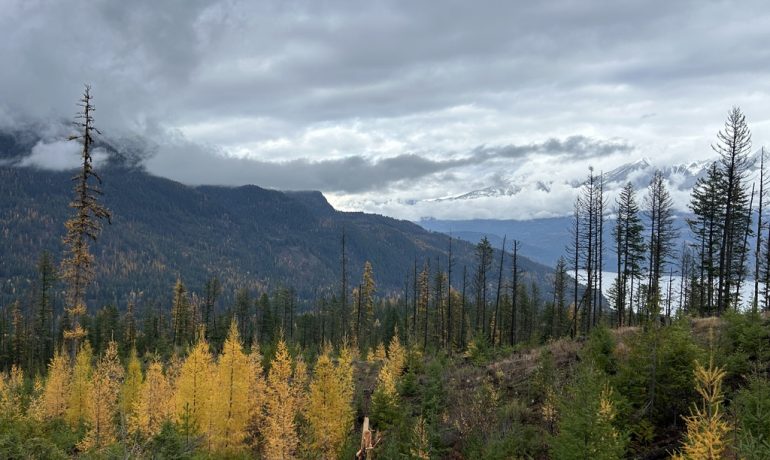From the Woodlot Licence and Community Forest Agreement Safety Committee
Trails in BC have a valuable role in our heritage, livelihoods and recreation. Users range from school kids, tourists, hikers, bikers and skiers to hunters and berry pickers.
Question: If one of those users is injured while using a trail that’s on your woodlot or community forest, will the licence holder(s) be held liable?
To answer this question, there are three things to consider:
1. whether or not the trail is legally recognized (i.e. has status),
2. who is the “occupier”, and
3. whether the occupier satisfied the required duty of care.
Determining whether or not the trail has “status”
Recreational trails can be established under section 56 of the Forest and Range Practices Act (FRPA) or section 6 of the Forest Practices Code of British Columbia Act or designated under the Forest Act. In addition, under section 57 of FRPA, the Minister of Forests, Lands, Natural Resource Operations and Rural Development (MFLNRORD) may authorize a person to construct and/or maintain a trail.
Trails that have cultural significance because of established aboriginal use or use by early immigrants acquire official status once they are designated as a heritage trail under the Heritage Conservation Act. Examples include the Grease Trail and the Hudson’s Bay Company Trail.
Trails that have been established, designated or authorized have status. Often, a maintenance agreement or management plan describes the terms and conditions of how the trail is to be maintained and used. For example, many mountain bike trails have been constructed under section 57 and they have status.
Trails that have not been established, designated or authorized by the Minister are “non-status trails”. There are plenty of mountain bike trails, hiking paths, ski routes and other trails that exist and are used by the public, but have no legal authorization or designation and therefore have no legal status.
TIP
Most trails that have legal status are mapped. Go to Recreation Sites and Trails in BC or iMapBC, or talk to a MFLNRORD Recreation Officer. Also, status trails are probably identified in your approved Woodlot Licence Plan or Forest Stewardship Plan.
How do you know who the occupier is?
The Occupiers Liability Act states an “occupier” is a person who (a) is in physical possession of premises, or (b) has responsibility for, and control over, the condition of premises, the activities conducted on those premises and the persons allowed to enter those premises,
It is not necessary to own the land to be an occupier, and there may be more than one occupier of the same premises. For example, for a status trail crossing a woodlot or a community forest, the licensee and the trail maintenance agreement holder could both be occupiers.
Satisfying your duty of care
The occupier(s) owes a duty of care to ensure that any person will be reasonably safe in using the premises (i.e. trail). That duty is to: (a) not create a danger with intent to do harm to the person or damage their property, and (b) not act with reckless disregard to the safety of the person or the integrity of their property.
For example, a licensee who installs a deactivation ditch across a status trail but does not notify the trail maintenance agreement holder or erect signs to warn users would not be meeting their duty of care.
The occupier(s) is subject to the duty of care described above as long as the use is for recreational activity and the occupier(s) receives no payment or other consideration for the entry or activity. If the trail construction or maintenance agreement holder has specified rules or conditions for use, erected signs and/or collect fees for use, they have effectively “invited” users to those trails and owe users a higher duty of care. They may be exposed to greater liability if someone is injured using that trail.
Liability Summary
Doing your due diligence goes a long ways to limiting liability. A person who uses a status trail in a Woodlot or Community Forest licence area is deemed to have willingly assumed all risks. The Licensee may be considered an occupier but as long as they satisfy the necessary duty of care, they would typically not be liable for injuries sustained by people using trails on their licence area.
TIP
If you see or know about hazards along trails in your licence area, communicate them to the maintenance agreement holder and/or Recreation Officer. If your forestry operations could pose risks to trail users, ask that the trail be closed during active operations.
Recreation Sites and Trails in BC – http://www.sitesandtrailsbc.ca/
iMapBC – https://www2.gov.bc.ca/gov/content/data/geographic-data-services
Related Post
Ensuring Worker Safety During Wind Events
New Safety Resource The frequency and magnitude of fall
Safe Tree Retention Guidance
The latest guidance from the Woodlots and Community Forests


